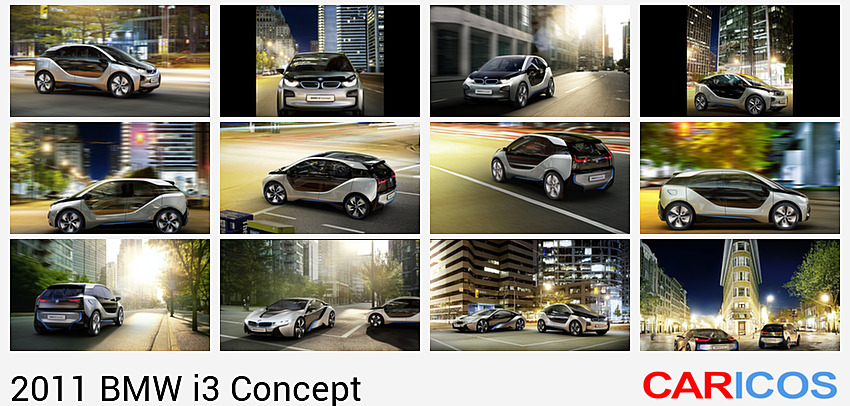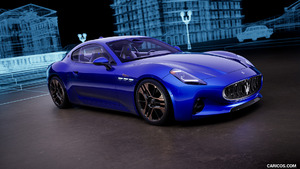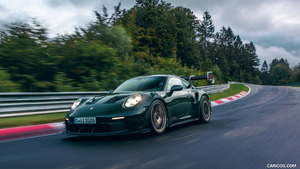BMW i3 And i8 Concepts
BMW i is about the development of visionary vehicles and mobility services, inspiring design and a new understanding of premium that is strongly defined by sustainability. With BMW i the BMW Group is adopting an all-embracing approach, redefining the understanding of personal mobility with purpose-built vehicle concepts, a focus on sustainability throughout the value chain and a range of complementary mobility services.
Two special vehicle concepts.
The BMW i brand is now poised to enter the consciousness of the automotive public with two new vehicles. On the one hand there is the BMW i3 Concept. Previously known as the Megacity Vehicle, the BMW Group’s first series-produced all-electric car focuses squarely on the mobility challenges in urban areas and, as the first premium electric vehicle, reinvents the hallmark BMW attributes for the future. Then comes the BMW i8 Concept, a sports car of the most contemporary variety – forward-looking, intelligent and innovative. Its unique plug-in hybrid solution brings together a combustion engine and an electric drive system to create an extraordinary driving experience complemented by extremely low fuel consumption and emissions.
BMW i3 Concept – dynamic, urban, emission-free.
The BMW i3 Concept is an uncompromisingly sustainable vehicle designed for urban areas. Driven purely by electric power and purpose-built to meet the demands of sustainable and emission-free mobility, it embodies an intelligent form of urban transportation and commuting.
The BMW i3 is a well-resolved all-round concept, with every detail conceived and optimised to fulfil its eventual purpose. Its innovative LifeDrive architecture renders the BMW i3 Concept light, safe, spacious and dynamic. Innovative use of materials and intelligent lightweight design, moreover, not only enable the i3 Concept to travel long distances on a single charge and provide superb safety in the event of a collision, they also help give the car its excellent driving dynamics. The electric motor over the rear axle – which generates output of 125 kW/170 hp and impressive torque of 250 Nm (184 lb-ft) from a standstill – and a small turning circle combine to deliver pleasingly crisp driving characteristics. The BMW i3 Concept accelerates from 0 to 60 km/h (37 mph) in under four seconds and from rest to 100 km/h (62 mph) in less than eight seconds.
The so-called Life module conjures up a feeling of space inside the car more generous than even the latest conversion vehicles can offer. Select materials lend the open and airy cabin a lounge-like character. The use of renewable raw materials is another defining characteristic of the interior, offering passengers a further means of “experiencing” the sustainability of the vehicle. Parts of the instrument panel and door panelling are visibly made from natural fibres, while the naturally tanned leather of the seats creates a lounge-style ambience. With four seats, wide-opening opposing “coach” doors, a boot capacity of around 200 litres and an additional functional compartment in the front, the BMW i3 Concept is neatly equipped for the demands of everyday use.
Innovative connectivity functions create a seamless connection between the BMW i3 Concept and its customers’ lives outside the car. Remote functions accessible via a smartphone enable owners to find their vehicles, flag up nearby charging stations, allow battery charging and preconditioning at the touch of a button, and supply information on the current status of the vehicle. Meanwhile, intelligent assistance systems ease the stress on drivers in monotonous city driving situations and allow them to arrive at their destination more safely and in a more relaxed state of mind.
BMW i8 Concept – emotional, dynamic and efficient.
The BMW i8 Concept and the fascinating approach that underpins it embody the vision of a sustainable contemporary sports car brought to life. Its innovative plug-in hybrid concept combines the modified electric drive system from the BMW i3 Concept – fitted over its front axle – with a high-performance three-cylinder combustion engine producing 164 kW/220 hp and 300 Nm (221 lb-ft) at the rear. Working in tandem, they allow the two drive systems to display their respective talents to the full, delivering the performance of a sports car but the fuel consumption of a small car.
Acceleration of 0 to 100 km/h (62 mph) in under five seconds combined with fuel consumption in the European cycle of under three litres per 100 kilometres (approx. 94 mpg imp) are figures currently beyond the capability of any vehicle powered by a combustion engine of comparable performance. Thanks to its large lithium-ion battery, which can be charged from a domestic power supply, the BMW i8 Concept can travel up to 35 kilometres (approx. 20 miles) on electric power alone. Added to which, the 2+2-seater offers enough space for four people, giving it a high level of everyday practicality.
The LifeDrive architecture of the BMW i8 Concept has been carefully adapted to enhance the vehicle’s sports car character, and therefore to deliver unbeatable performance and excellent driving dynamics. The motor in the front axle module and combustion engine at the rear are connected by an “energy tunnel”, which houses the high-voltage battery. This gives the car a low centre of gravity – and the dynamic benefits that come with it. The positioning of the electric motor and engine over their respective axles and the space-saving and well-balanced packaging of all components result in an optimum 50/50 weight distribution.
The emotional design of the BMW i8 Concept ensures its qualities are clear for all to see. Its dynamic proportions give the BMW i8 Concept the appearance of surging forward before it even turns a wheel and lend visual form to its extraordinary performance.
The sporting character continues into the interior. Boasting a driver-focused environment unmatched by any BMW Group vehicle before it, the BMW i8 Concept immerses the driver fully in the unique driving experience. The BMW i8 Concept is the sports car for a new generation – pure, emotional and sustainable.
BMW i thinks beyond the vehicle.
An additional range of mobility services – which can also be used independently of the cars – will be an integral component of BMW i alongside the vehicles themselves. A totally new development in this area will be vehicle-independent mobility services. Here the focus is on solutions which will improve usage of existing parking spaces, as well as intelligent navigation systems with local information, intermodal route planning and premium car-sharing. In addition to service packages developed in-house, the BMW Group is pursuing cooperations with partner companies as well as strategic capital investments with providers of mobility services. BMW i Ventures was established with this purpose in mind. The company aims to expand the product portfolio of BMW i over the long term with stakes in highly innovative service providers, such as MyCityWay and ParkatmyHouse.
Purpose-built design – the LifeDrive concept.
Unlike the “conversion” approach applied up to now, which involves integrating electric components into vehicles originally designed to be powered by a combustion engine, the innovative LifeDrive architecture of the BMW i vehicles focuses directly on the technical requirements of the electric drive train. In this way the electric motor and the battery can be optimally accommodated and, in combination with intelligent lightweight design and innovative use of materials, the electrification of the vehicle can be achieved without having to carry out complex modifications and without adding weight. In this way, the LifeDrive architecture marries low overall weight for a maximised range with generous levels of space, supreme driving characteristics and high safety levels for the battery and passengers.
In contrast to vehicles with a self-supporting body, the LifeDrive concept essentially comprises two separate, independent functional units. The Drive module integrates the vehicle’s suspension, battery, drive system, and structural and crash functions into a construction made chiefly from aluminium. Its partner, the Life module, consists primarily of a high-strength and extremely lightweight passenger cell made from carbon fibre-reinforced plastic (CFRP). The use of this high-tech material across large sections of the car ensures that the Life module is remarkably light and, in so doing, helps to achieve both impressive range and improved performance. With this innovative concept the BMW Group has taken lightweight design, vehicle architecture and crash safety into a whole new dimension. Like the cockpit of a Formula One car, the CFRP passenger cell provides an extremely strong survival area. Pole impacts, side-on collisions and rollover tests highlight the impressive safety-enhancing properties of this extraordinarily robust material.
The LifeDrive architecture of the BMW i3 Concept.
Both the BMW i3 Concept and the BMW i8 Concept feature the LifeDrive architecture, but the geometric implementation of the concept differs in the two models, having been adapted to suit their different usages. The BMW i3 Concept features a horizontal-split variant of the LifeDrive concept. Here, the Drive module provides the solid foundations for the Life cell, which is simply mounted on top. The reason for this functional rendition of the LifeDrive architecture is the large battery. In order to ensure the greatest possible electric range, the battery in the BMW i3 Concept is correspondingly large. The most space-efficient place to store the battery cells was in the car’s underfloor section, where they occupy the whole of the module’s central section, giving the car optimum weight distribution and a low centre of gravity. The battery is penned in by aluminium profiles, which protect it from external impacts. Crash-active structures in front and behind it provide the necessary energy absorption in the event of a front- or rear-end collision. The electric drive system is, as a whole, much more compact than a comparable combustion engine, cleverly accommodating the electric motor, gear assembly and drive electronics – in space-saving fashion – within a small area over the driven rear axle. The BMW i3 Concept therefore features the optimum LifeDrive architecture configuration for a purely electric vehicle.
The integration of all the drive components within the Drive module removes the need for a centre tunnel bisecting the interior, through which power would previously have been transferred to the rear wheels. The BMW i3 Concept therefore offers significantly more interior space than other vehicles with the same wheelbase and – through solutions such as a full-width seat bench – also allows the interior to be adapted extremely effectively to the needs of urban mobility. The BMW i3 Concept offers comfortable accommodation for four passengers and, with around 200 litres of boot space, room for their luggage as well.
The chassis of the BMW i3 Concept is also ideal for city driving. Its enviably small turning circle and direct steering responses are a recipe for outstanding agility, notably at low speeds.
The LifeDrive architecture of the BMW i8 Concept.
The BMW i8 Concept sees the LifeDrive architecture concept adapted to suit the vehicle’s sports car character – i.e. primed to deliver leading performance and sharp dynamics. In a departure from the purely horizontal configuration favoured for the BMW i3 Concept, the LifeDrive architecture of its BMW i8 Concept sibling also features vertical layering. The drive systems powering the BMW i8 Concept are integrated into the front and rear axle modules, with the CFRP Life module providing the bridge between the two.
As a plug-in hybrid, the BMW i8 Concept is not designed purely for all-electric propulsion, and therefore carries fewer battery cells than the BMW i3 Concept. These are stored in the Life module inside the energy tunnel, a structure similar to a central transmission tunnel.
The front and rear axle modules therefore combine with the passenger cell and battery to form a functional unit, which adopts not only load-bearing responsibilities but also extensive crash functions. The location of the high-voltage battery in the energy tunnel gives the vehicle a low centre of gravity, and this enhances its dynamics. Together with the positioning of the motor and engine over the axles, the result is optimum 50/50 weight distribution. Intelligent lightweight design and the innovative use of materials produce extremely low unsprung and rotating masses, which is good news for the car’s driving dynamics, acceleration, range and fuel economy. All in all, the BMW i8 Concept offers the ideal environment in which to experience the special drive concept and distinctive sports car character of the BMW i8 Concept on the road.
The axles are also designed to deliver optimum handling properties, in keeping with the car’s sporting profile. Thus the multi-link front axle makes for an extremely flat and aerodynamically efficient silhouette while also eliminating any drive forces which may otherwise affect the steering, ensuring optimum handling in every situation.














